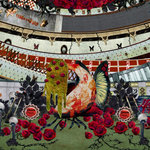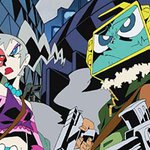The List
8 Most Visually Striking Anime Productions
by Lynzee Loveridge,

This week's countdown works as a double-list of sorts. There was no way to list off the most visually striking works without mentioning the directors who led them. If you explore through ANN's encyclopedia enough, you'll notice that several directors in the list worked as staff members on other entries. There's certainly a creative community for artists thinking, or in this case drawing, outside of the box.
 8. Puella Magi Madoka Magica's Labyrinths (Gekidan Inu Curry)
8. Puella Magi Madoka Magica's Labyrinths (Gekidan Inu Curry)
Inucurry's otherwordly designs for the witches' labyrinths in Madoka Magica appeared in the series' first episode and they hit hard. The audience is initially introduced to a by-the-numbers magical girl series with some futuristic elements. We start with a disastrous dream sequence (à la Card Captor Sakura, Sailor Moon, etc.), the cute-but-shy lead, her family, and her school life. It's when Madoka stumbles into a witch's lair and we're introduced to Inu Curry's Freudian-like art that the stage is set for something extraordinary. The environments leave a lot for the audience to analyze with their cryptic transcriptions and psychological themes.
Other works of note: Maria Holic ending sequence
 7. Serial Experiments Lain (Ryutaro Nakamura)
7. Serial Experiments Lain (Ryutaro Nakamura)
Serial Experiments Lain was the 1990s allegory for the soon-to-come NEET and hikkomori phenomenon would draw media and government attention a half-decade later. Isolation and communication are major themes within the series, a point the art drives home. Buzzing telephone lines cast shadows on the stark white ground, flecked with an unsettling red. Lain walks to school each morning, almost blinded by the world outside her room. Wires, computers and cellphones are abstract characters unto themselves. The character designs are credited to none other than Yoshitoshi ABe, whose iconic designs appear in the post-apocalyptic Texhnolyze and supernatural drama Haibane Renmei.
Other works of note: Ghost Hound, Kino's Journey
 6. Mononoke (Kenji Nakamura)
6. Mononoke (Kenji Nakamura)
Mononoke takes a stylistic approach similar to this season's Uta Koi, albeit a more committed one. The series' itself is gorgeous to look at, featuring a pastel palette with layers of blocked texture. Every scene appears drawn on creased rice paper, emphasizing the show's roots in traditional Japanese art. Symbolism plays a large part in the show's arcs while recurring themes such as shoji doors and overwhelmingly large structures cower around the characters. Unfortunately, Mononoke has yet to be released stateside and it's predecessor, Ayakashi- Samurai Horror Tales was released by Geneon USA in 2007, but was not rescued. The art staff (Takashi Kurahashi, Yumi Hosaka, and Takashi Hashimoto) are currently involved in Toei's Kyousogiga project.
Other works of note: Kūchū Buranko, tsuritama
 5. Kemonozume (Masaaki Yuasa)
5. Kemonozume (Masaaki Yuasa)
It could be argued that Kemonozume's art is ugly and it wouldn't be an entirely unfair assessment. It sloughs off the audience's expectations of anime aesthetics in place of fluidity. It bares some similarities to Production I.G.'s Kill Bill anime segments but more grotesque. The series' monsters and subsequent gore are lovingly detailed while human faces are ever-moving wheels of expressions. It's surprising the series never received a stateside release, because while the artistry may not jive with the typical anime fan it might find its niche with [adult swim]'s Western animation fans. There's enough sexual content to titillate, gory-action for horror fans, and an interesting love story.
Other works of note: Kaiba, Mind Game, The Tatami Galaxy
 4. Dead Leaves (Hiroyuki Imaishi)
4. Dead Leaves (Hiroyuki Imaishi)
Imaishi's debut work with artist Imaitoonz is a 50-minute adrenaline rush of action-comedy that deftly introduces Imaishi's style. The aesthetic and color palette is tweaked in his later series, Panty & Stocking with Garterbelt but its Western influences are still present. The art makes heavy use of black shading, similar to Viewtiful Joe, but with a darker color scheme and post-apocalyptic destruction. The visuals lend itself to comedy easily, although it helps when the lead character has a TV for a head.
Other works of note: Gurren Lagann, Panty & Stocking with Garterbelt
 3. Revolutionary Girl Utena: The Movie (Kunihiko Ikuhara/Be-Papas)
3. Revolutionary Girl Utena: The Movie (Kunihiko Ikuhara/Be-Papas)
The Utena movie sometimes gets a bad rap from fans of the series. It's understandable, especially if you watch the two back-to-back, but to do so misses Ikuhara's point entirely. The film is supposed to be a "celebration" of the series, and it achieves this artfully. It's hard to pick a defining moment for this film; it's a moving series of art pieces from start to finish with references to artists like photographer Edward Weston. The ending might go off the rails and characterization leaves something to be desired compared to its predecessor, but it is a beautiful film.
Other works of note: Mawaru Penguindrum
 2. Bakemonogatari (Akiyuki Shinbo)
2. Bakemonogatari (Akiyuki Shinbo)
Akiyuki Shinbo's style of quick angle changes, flashy colors, and interlaced symbols is becoming quickly identifiable thanks to his ever growing body of work. It was difficult for me to pick which series best exemplifies his artistic take on the medium but Bakemonogatari and its subsequent sequels are one of the most striking (with Sayonara, Zetsubou-sensei a close second). The series relies heavily on geometric-patterned backgrounds and light and shadow. The repetitive shapes feel confining and overwhelming, tying to the series' focus on characters cursed by their pasts or insecurities. The use of interlaced frames of kanji and images lets the audience in on character thought patterns while symbolic objects multiply between cut scenes. Bakemonogatari is a fast-paced visual overload, but its unequivocal uniqueness stands out in a sea of expected offerings.
Other works of note: Arakawa Under the Bridge, Maria Holic, Le Portrait de Petite Cossette, Puella Magi Madoka Magica, The SoulTaker, Sayonara, Zetsubou-Sensei
 1. Paprika (Satoshi Kon)
1. Paprika (Satoshi Kon)
Satoshi's Kon final completed work is a perfect blend of psychological symbolism, lush attention to detail, and immersing environments. It's rare to find an animated work whose visual cues reveal so much about the characters' motivations, psyche, and relationships. The world of dreams blur with reality (a similar concept is touched on in Perfect Blue) in a mix of the fantastic yet disturbing displays of the minds of the mentally ill. Paprika herself is always on the run, and it's in her transforming chase scenes (Goku to Fairy to Sphynx to Mermaid) that the animation direction takes a life of its own. The community lost a great visionary with the passing of Kon, but Paprika stands tantamount to visual perfection.
Other works of note: Perfect Blue, Paranoia Agent, Kaikisen (manga)

The new poll: Ever been in a situation and found yourself vastly outnumbered? Usually your best friend has your back, but some cases require a person with a certain set of skills. So tell me, what anime bodyguard would you trust with your life? Vote in the survey and then tell us why your choice trumps the rest in the forums.
The old poll: I expected last week to be close with Shana fans going head to head with Toradora! and Hayate the Combat Butler fans, but I was way off. Taiga Aisaka won by a landslide with almost 50% of the votes. Here's the full results:
- Taiga Aisaka (Toradora!) 47.8%
- Shana (Shakugan no Shana) 18.1%
- Nagi Sanzenin (Hayate the Combat Butler) 11.7%
- Louise Françoise Le Blanc de La Vallière (The Familiar of Zero) 11.0%
- Tōko Matsudaira (Maria Watches Over Us) 3.6%
- Iori Minase (IDOLM@STER) 3.3%
- Aria H. Kanzaki (Aria the Scarlet Ammo) 2.4%
- Astarotte "Lotte" Ygvar (Astarotte's Toy) 2.0%
Alright everybody, see you all next week! I look forward to your input in the comments and feel free to follow me on Twitter @ANN_Lynzee.
discuss this in the forum (104 posts) |